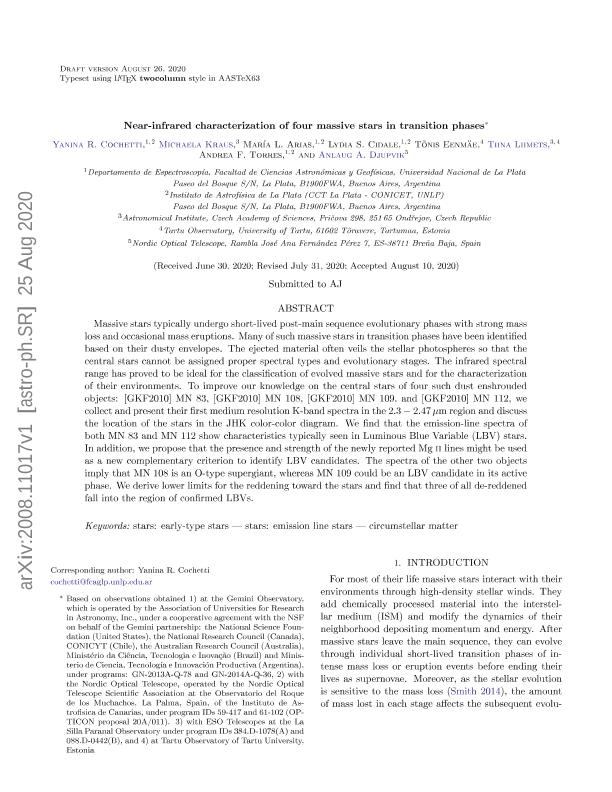Artículo
Near-infrared Characterization of Four Massive Stars in Transition Phases
Cochetti, Yanina Roxana ; Kraus, Michaela; Arias, María Laura
; Kraus, Michaela; Arias, María Laura ; Cidale, Lydia Sonia
; Cidale, Lydia Sonia ; Eenmäe, Tõnis; Liimets, Tiina; Torres, Andrea Fabiana
; Eenmäe, Tõnis; Liimets, Tiina; Torres, Andrea Fabiana ; Djupvik, Anlaug A.
; Djupvik, Anlaug A.
 ; Kraus, Michaela; Arias, María Laura
; Kraus, Michaela; Arias, María Laura ; Cidale, Lydia Sonia
; Cidale, Lydia Sonia ; Eenmäe, Tõnis; Liimets, Tiina; Torres, Andrea Fabiana
; Eenmäe, Tõnis; Liimets, Tiina; Torres, Andrea Fabiana ; Djupvik, Anlaug A.
; Djupvik, Anlaug A.
Fecha de publicación:
10/2020
Editorial:
IOP Publishing
Revista:
Astronomical Journal
ISSN:
0004-6256
e-ISSN:
1538-3881
Idioma:
Inglés
Tipo de recurso:
Artículo publicado
Clasificación temática:
Resumen
Massive stars typically undergo short-lived post-main-sequence evolutionary phases with strong mass loss and occasional mass eruptions. Many of such massive stars in transition phases have been identified based on their dusty envelopes. The ejected material often veils the stellar photospheres so that the central stars cannot be assigned proper spectral types and evolutionary stages. The infrared spectral range has proved to be ideal for the classification of evolved massive stars and for the characterization of their environments. To improve our knowledge on the central stars of four such dust-enshrouded objects, [GKF 2010] MN 83, [GKF 2010] MN 108, [GKF 2010] MN 109, and [GKF 2010] MN 112, we collect and present their first medium-resolution K-band spectra in the 2.3-2.47 μm region and discuss the location of the stars in the JHK color-color diagram. We find that the emission-line spectra of both MN 83 and MN 112 show characteristics typically seen in luminous blue variable (LBV) stars. In addition, we propose that the presence and strength of the newly reported Mg II lines might be used as a new complementary criterion to identify LBV candidates. The spectra of the other two objects imply that MN 108 is an O-type supergiant, whereas MN 109 could be an LBV candidate in its active phase. We derive lower limits for the reddening toward the stars and find that three of all dereddened fall into the region of confirmed LBVs.
Palabras clave:
EARLY-TYPE STARS
,
CIRCUMSTELLAR MATTER
,
EMISSION LINES
Archivos asociados
Licencia
Identificadores
Colecciones
Articulos(IALP)
Articulos de INST.DE ASTROFISICA LA PLATA
Articulos de INST.DE ASTROFISICA LA PLATA
Citación
Cochetti, Yanina Roxana; Kraus, Michaela; Arias, María Laura; Cidale, Lydia Sonia; Eenmäe, Tõnis; et al.; Near-infrared Characterization of Four Massive Stars in Transition Phases; IOP Publishing; Astronomical Journal; 160; 4; 10-2020; 166-169
Compartir
Altmétricas



